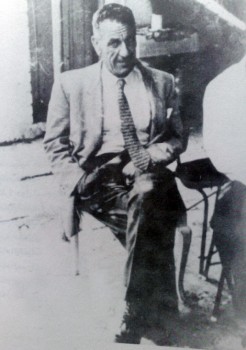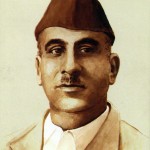The Arab Music Archiving and Research foundation (AMAR), in collaboration with the Sharjah Art Foundation (SAF), presents “Min al-Tārīkh”.
Dear listeners,
Welcome to a new episode of “Min al-Tārīkh”.
Today, we will be resuming with our guest Mr. Husayn al-A‘zami our discussion about al-ṭarīqa al-Qundargiyya, i.e. Rashīd al-Qundargī’s ṭarīqa, and its followers.
Who are the most famous disciples of this ṭarīqa, Mr. Husayn?
The major disciples of Rashīd al-Qundargī’s ṭarīqa include Ḥasqīl Qaṣṣāb, an Iraqi Jew born in the last decade of the 19th century –year unknown– who passed away in 1969, whom we gave the title of “Pioneer of the New Classicism in maqām singing”. He is one the major singers among Iraqi Jews, and witnessed a quite developed phase of the recording era. In fact, he clarified many issues. Furthermore, Ḥasqīl Qaṣṣāb sang a lot. If Mr. Mustafa Said would allow me, I would like to point out that many of our Iraqi brothers and in particular the audience –that has a significant influence on the aesthetics level, not on the level of specialisation that falls to experts, singers, instrumentalists, critics, and writers with whom we can discuss the subject directly– give us a scale of the aesthetics they hear, and which constitute the important element, i.e. the aesthetics of performance and thrill. To most audiences until today, and especially after the invasion of Iraq in 2003, Iraqi Jews are those who preserved maqām, who know about maqām, etc. In my opinion, these statements are not correct, as I have listened to numerous Iraqi Jewish singers, whom I enjoy listening to, but this is another subject because the critical subject must be mentioned… whether I like something or not is secondary and bears no relation to the scientific issue. Even Iraqi Jew Kojaman based in London, who authored a major book on Iraqi maqām music –a master’s thesis– stated that the role played by Iraqi Jews in music is not the same as the role they played in singing: they were undoubtedly almost the only musicians present on the scene, especially from the late 19th century up until the first half of the 20th century, the early 1950s, when Iraqi Jews started to immigrate to occupied Palestine.
The word “musicians” implies instrumentalists.
Exactly. They played a major role as instrumentalists, but not as singers. Whereas Arab or non-Arab Muslims played the major role as Iraqi maqām singers, which is quite natural, since, as mentioned earlier, maqām-s are based on the religious element of religious rituals, and especially the Muslim rituals, since Muslim citizens were the great majority, added to Sufi ṭarīqa-s and other ṭarīqa-s. Thus, the Muslim singers who performed Iraqi maqām-s, whether in religious or in mundane rites, were the closest to a quality and correct performance from a historical traditional perspective. I selected out of various books examples of Iraqi Jewish singers, analysed some of their maqām-s, and listed the lacks in their performance compared to the historical traditional maqām form. These singers include Ḥasqīl Qaṣṣāb, Yūsuf Ḥuraysh, and Salīm Shubbat. In conclusion, the role played by Jewish singers of Iraqi maqām is minimal as compared to their role in music.
Let us go back to al-Qundargī’s disciples.
Now concerning Ḥasqīl Qaṣṣāb’s classicism: many of the maqām-s he sang are not bad artistically, as much as they highlight his insistence on applying the principles or uṣūl of maqām…
(♩)
I differentiated Ḥasqīl Qaṣṣāb from the others because he did not choose to crowd the maqām with too many qiṭa‘ and awṣāl: he neither sought scale modulations between maqām-s or between jins, nor a complex performance. He did not elaborate modulations and preserved the nature of the sung maqām.
Like al-Qundargī… Al-Qundargī is concise.
Exactly. He did not shorten the duration, he only did not perform many modulations. This was my major point about Ḥasqīl… who might have found this difficult… yet this is the muṭrib’s problem, not ours as listeners.
A simple performance has its beauty, not modulating between maqām-s and setting on a note has its beauty that I sometimes appreciate.
It can be beautiful sometimes. The important thing is how the singer conveys his feelings.
I have listened to numerous maqām-s performed by Ḥasqīl Qaṣṣāb in their historical maqām form –unfortunately, I can only talk now about the few maqām-s that I have heard and that belong to my music collection. The expression “muṭrib uṣūlī” that can be applied to Ḥasqīl Qaṣṣāb is the dominating attribute in the description by maqām critics as well as in the point of view of the audience relatively to the maqām-s that he sang. This truly muṭrib uṣūlī held on to the principles or uṣūl of the ṭarīqa Qundargiyya whose major characteristic is respecting the uṣūl of maqām. Some critics are right in objecting the imprecision of the word “uṣūlī”, knowing that the imprecision of this attribute only reflects the many possibilities as to determining the uṣūl of maqām during this period of fast growing transformations and developments, despite the relatively fixed nature of these uṣūl of maqām representing the maqām form. Muṭrib Ḥasqīl Qaṣṣāb applies in his maqām the uṣūl that were fixed during his period. It is important to note this because more and more qiṭa‘ and awṣāl were entered within maqām-s with time. So his performances reflect his period and represent the qiṭa‘ and awṣāl existing in a certain maqām at the time. He did not elaborate… this is an important point. These uṣūl were subject to changes, additions, and developments upon the spreading of al-ṭarīqa al-Qubbāngiyya: al-Qubbāngī entered an increased number of those. In fact, he made many additions, and everything he brought became final and was to be followed by singers. In my book on al-ṭarīqa al-Qundargiyya and its disciples, I analysed some maqām-s including the maqām ‘araybūn ‘arab. He sang the ‘araybūn ‘ajam and the ‘araybūn ‘arab:
The ‘araybūn ‘arab “Yā galb w-ēsh ṭayyaḥak bi-ḥbāluhum we-shrāk”. I analysed this maqām performed by Ḥasqīl, added to the maqām ḥusaynī, Ḥasqīl’s maqām khanabāt, the maqām jubūrī, and the maqām taflīs…
(♩)
Dear listeners,
We have reached the end of today’s episode of “Min al-Tārīkh”.
We have listened today to both the maqām ḥadīdī and the maqām taflīs performed by Ḥasqīl Qaṣṣāb.
We will meet again in a new episode to resume our discussion with Mr. Husayn al-A‘zami about al-ṭarīqa al-Qundargiyya and its followers.
We thank Mr. Husayn al-A‘zami.
“Min al-Tārīkh” is brought to you by Mustafa Said.
- 221 – Zakariyya Ahmed – 12 (1/9/2022)
- 220 – Zakariyya Ahmed – 11 (1/9/2022)
- 219 – Zakariyya Ahmed – 10 (11/25/2021)
- 218 – Zakariyya Ahmed – 9 (10/26/2021)
- 217 – Zakariyya Ahmed – 8 (9/24/2021)
- 216 – Zakariyya Ahmed – 7 (9/4/2021)
- 215 – Zakariyya Ahmed – 6 (8/28/2021)
- 214 – Zakariyya Ahmed – 5 (8/6/2021)
- 213 – Zakariyya Ahmed – 4 (6/26/2021)
- 212 – Zakariyya Ahmed – 3 (5/27/2021)
- 211 – Zakariyya Ahmed – 2 (5/1/2021)
- 210 – Zakariyya Ahmed – 1 (4/28/2021)
- 209 – W-al-Lāhi lā astaṭī‘u ṣaddak 2 (4/6/2017)
- 208 – W-al-Lāhi lā astaṭī‘u ṣaddak 1 (3/30/2017)
- 207 – Bashraf qarah baṭāq 7 (3/23/2017)



